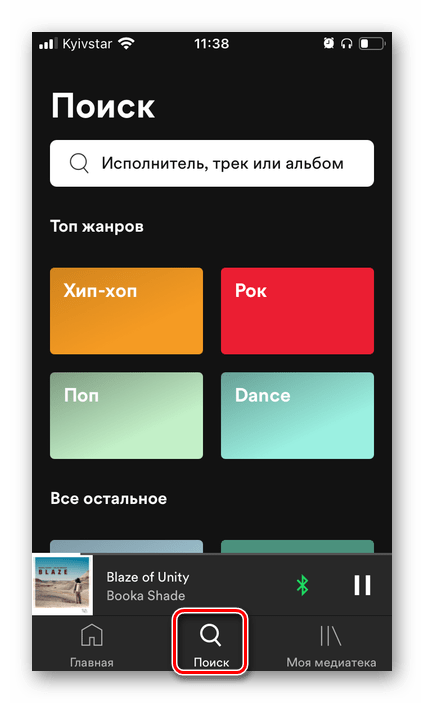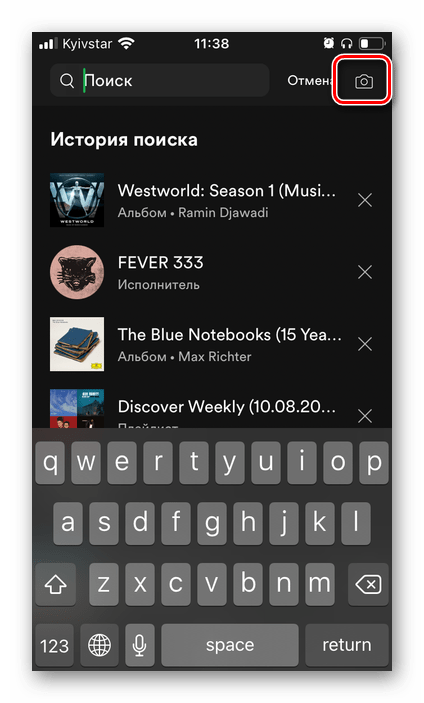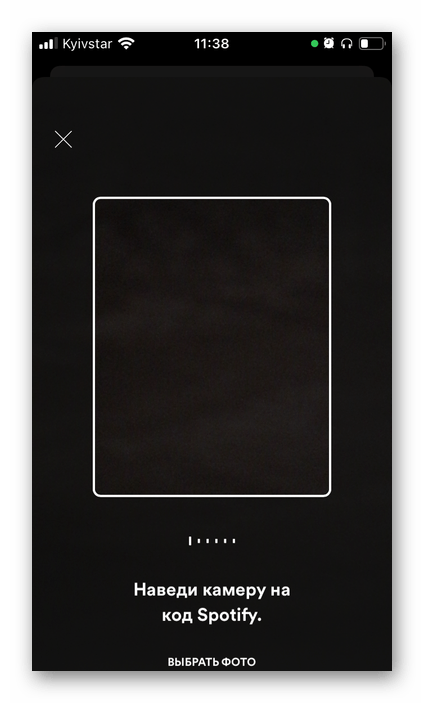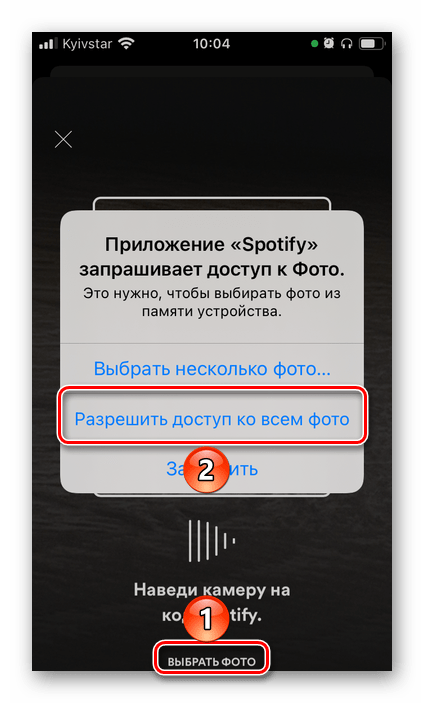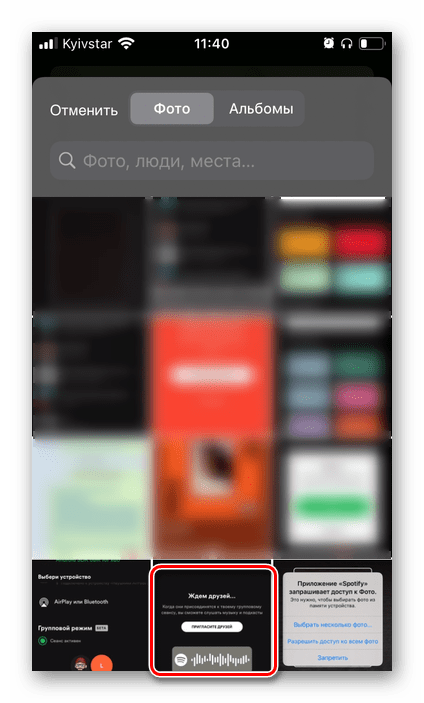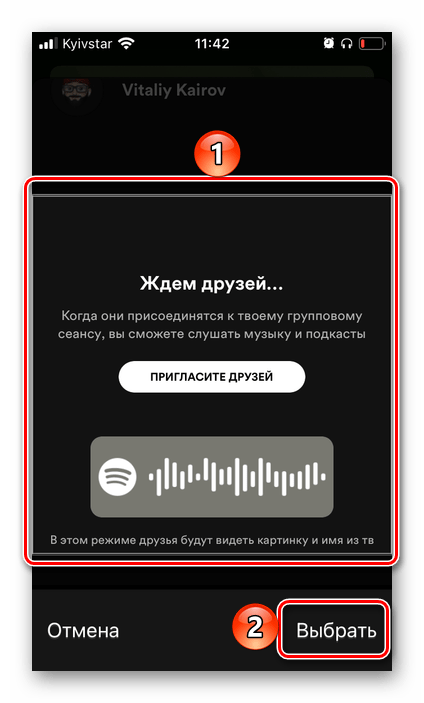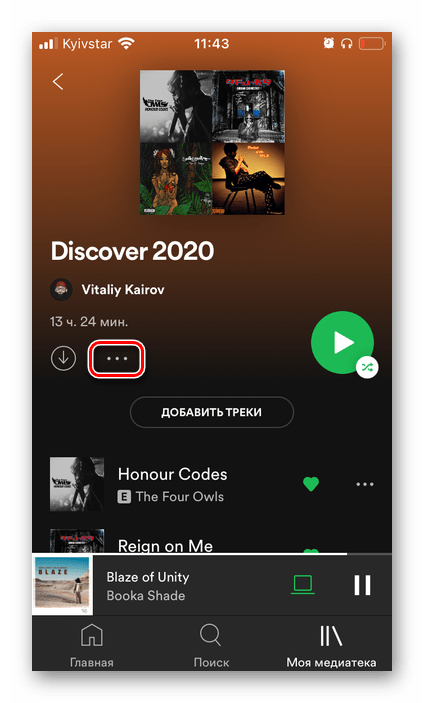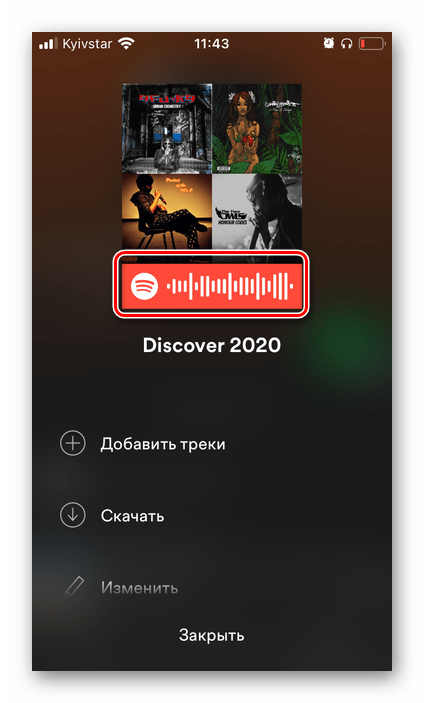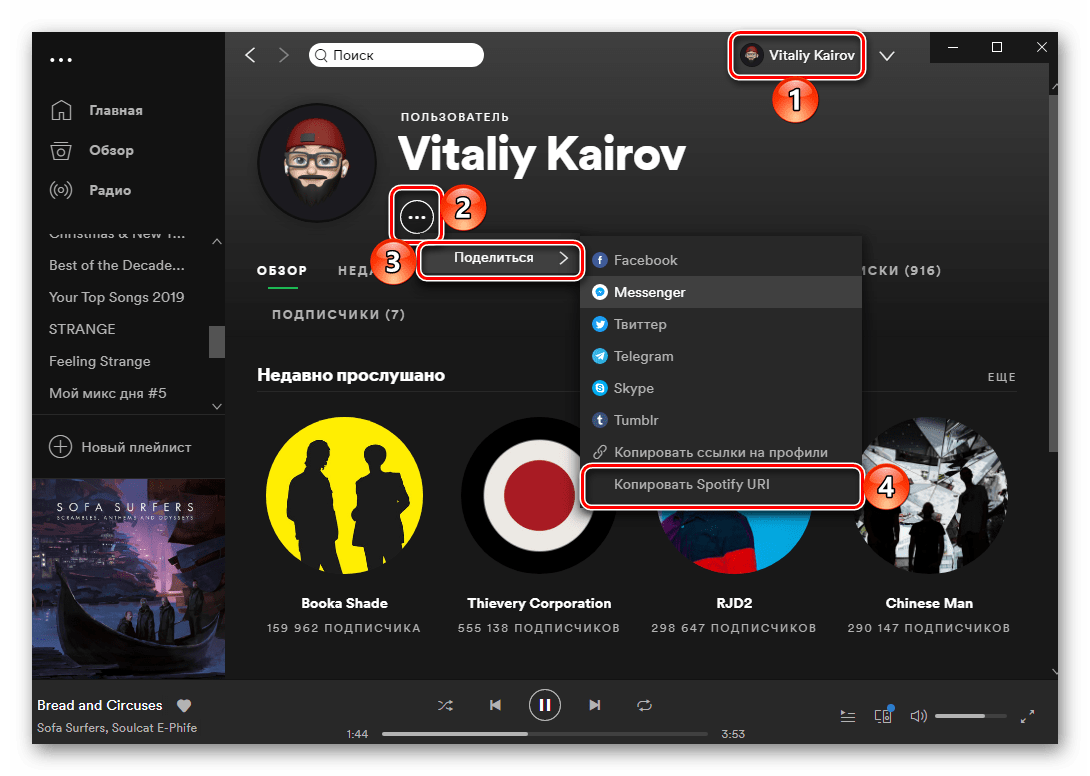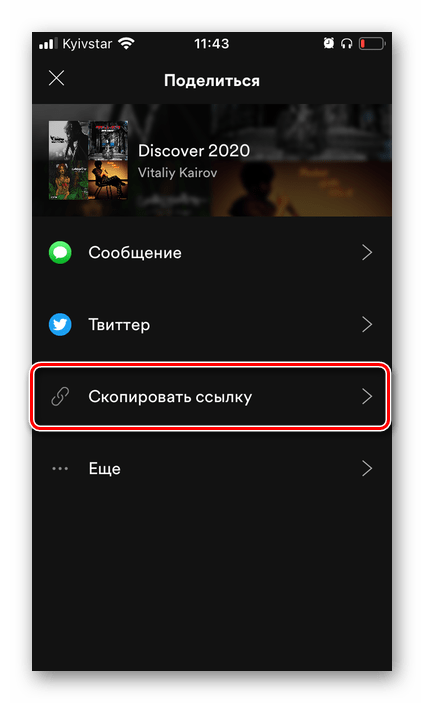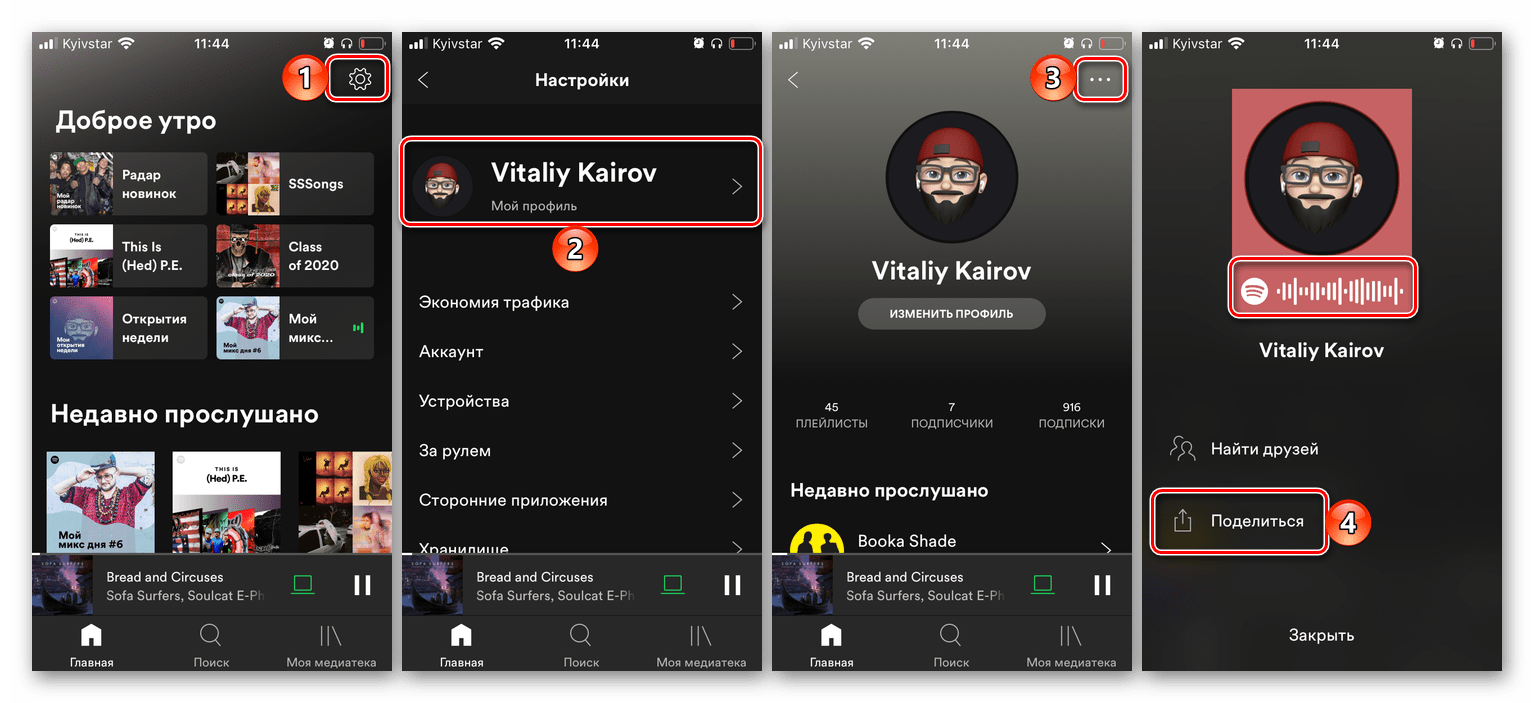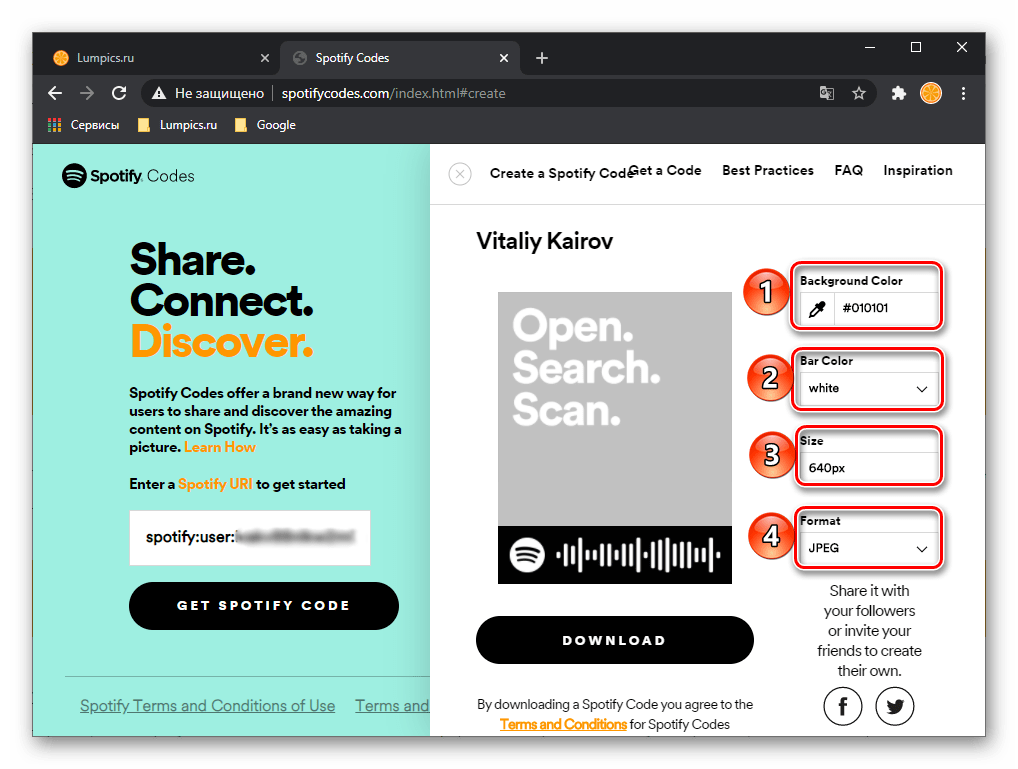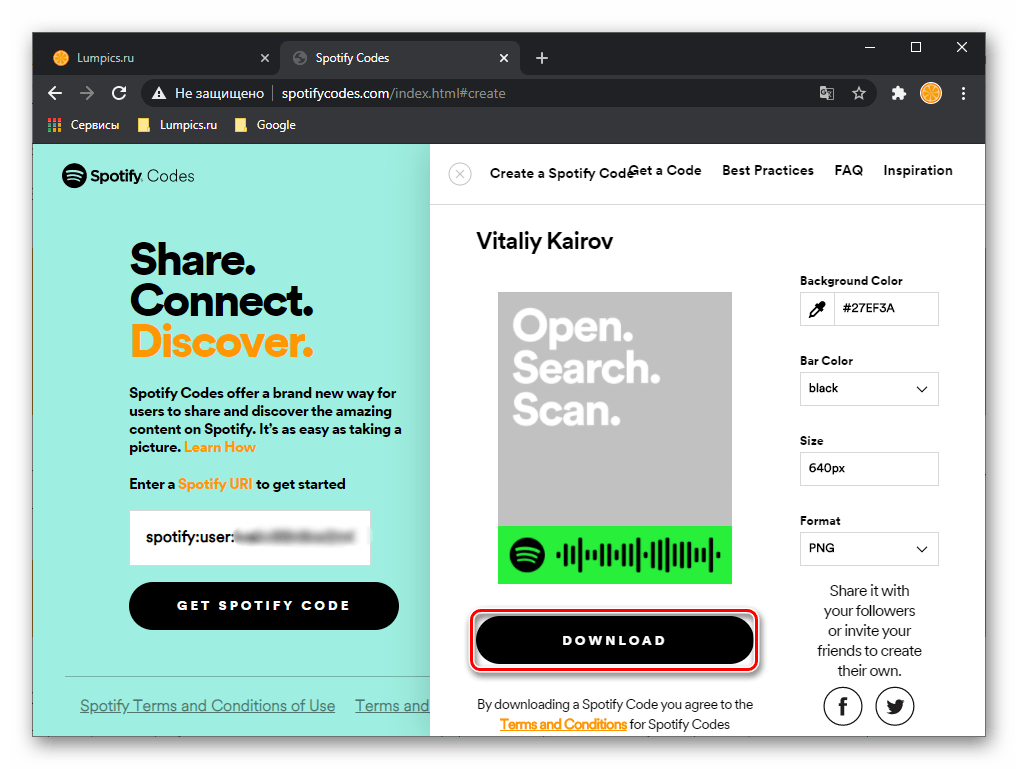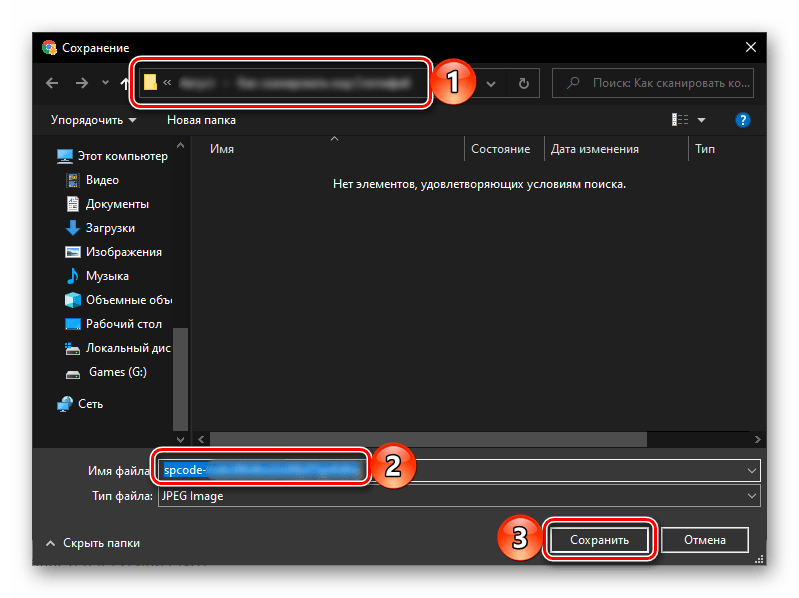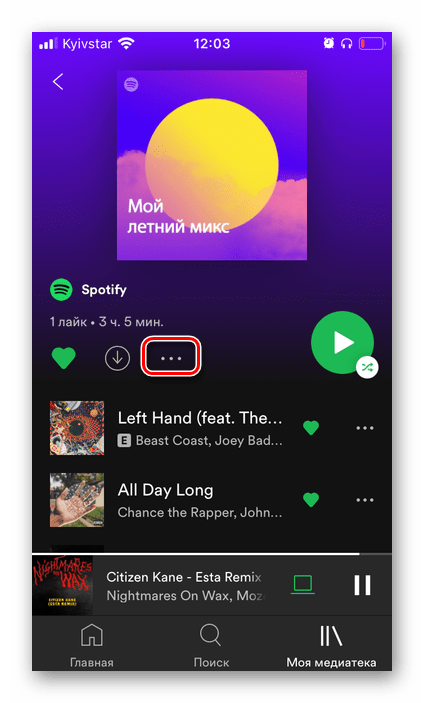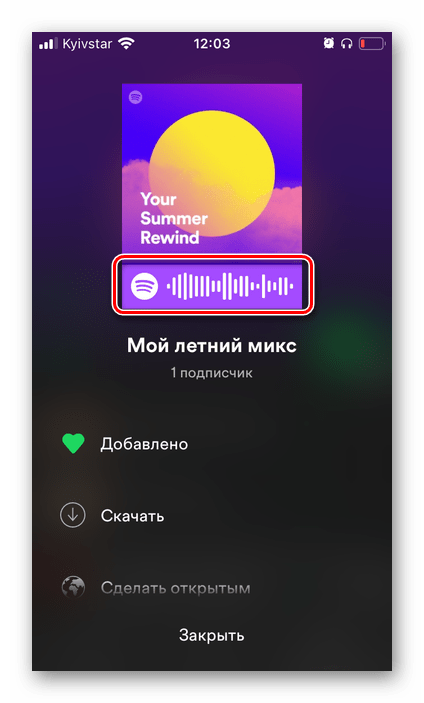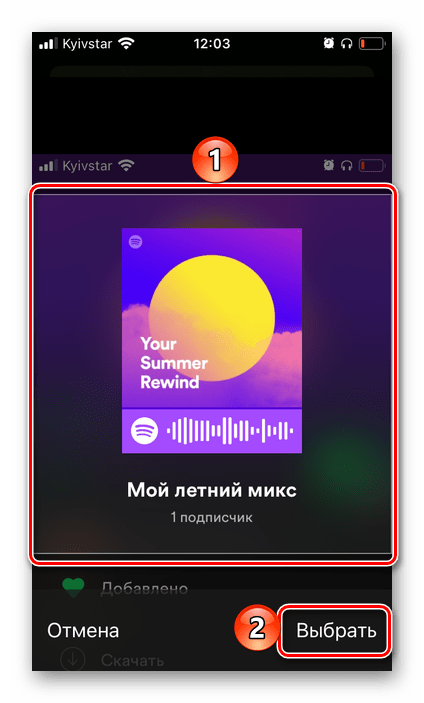как узнать спотифай токен
Как отсканировать код Spotify
Важно! Отсканировать код можно только на смартфоне и планшете с Android и iOS/iPadOS, на котором установлено мобильное приложение Spotify.
Вариант 1: Камера
Коды Спотифай часто используются для продвижения контента, а потому их можно встретить не только на стриминговом сервисе, но и на многих других сайтах в интернете, в рекламе и даже в реальной жизни (бигборды, афиши, плакаты, стикеры и т. д.). Отсканировать их можно с помощью встроенной в приложение камеры.
Сразу после этого откроется страница, для которой код создавался.
Вариант 2: Изображение
Спотифай также умеет сканировать коды не только через камеру, но и с изображений, сохраненных в памяти устройства. Для этого:
Одной из сфер применения кодов Spotify является групповой режим, который позволяет слушать музыку совместно с друзьями. Узнать более детально о его особенностях можно из представленной по ссылке ниже статьи.
Как создать собственный код Spotify
Спотифай позволяет создавать собственные коды для плейлистов, благодаря чему ими можно удобно делиться с друзьями.
и выберите пункт «Поделиться».
Примечание: В мобильном приложении Спотифай у всех ваших плейлистов уже есть свои коды.
На смартфонах и планшетах следует выбирать «Скопировать ссылку».
Обратите внимание! Вы также можете поделиться своей страницей. Для того чтобы перейти к ней в программе, достаточно нажать по своему имени в правом верхнем углу. В мобильном приложении необходимо открыть «Настройки», а затем тапнуть по изображению своего профиля (но там же доступен и готовый код). В обоих случаях вам будет доступно меню, через которое и можно получить ссылку.
Важно! В браузере Safari сайт работает некорректно, поэтому необходимые манипуляции выполнить не получится.
чтобы скачать изображение.
По желанию вы также можете отредактировать это изображение. Обратите внимание, что загружается только область с кодом (зеленый прямоугольник в нашем примере, показанный выше), но при желании из него можно сделать уникальную обложку, поместив на место надписи «Open. Search. Scan» свою картинку.
Как поделиться кодом Spotify
Коды Спотифай являются таким же идентификаторами контента, как и ссылки. Они закреплены за страницами пользователей и исполнителей, альбомами, плейлистами и, как мы уже выяснили, могут быть созданы самостоятельно, а значит, ими тоже можно делиться.
Несложно догадаться, что оба метода применимы и для самостоятельно созданных кодов, которые можно как демонстрировать на экране, так и отправлять в виде файлов.
Помимо этой статьи, на сайте еще 12226 инструкций.
Добавьте сайт Lumpics.ru в закладки (CTRL+D) и мы точно еще пригодимся вам.
Отблагодарите автора, поделитесь статьей в социальных сетях.
Authorization Guide
To have the end user approve your app for access to their Spotify data and features, or to have your app fetch data from Spotify, you need to authorize your application.
Your app can be authorized by Spotify in two ways:
Obtaining Authorization
Making authorized requests to the Spotify platform requires that you are granted permission to access data.
In accordance with RFC-6749, 3 parties are involved in the authorization process:
Scopes
Scopes enable your application to access specific API endpoints on behalf of a user. The set of scopes you pass in your call determines the access permissions that the user is required to grant. See available scopes.
Example
The following code generates a request for the scopes user-read-private and user-read-email :
On execution, the user is redirected to a page where the requested information is presented:
To Obtain Authorization:
Authorization Flows
There are four optional flows to obtaining app authorization:
For further information and examples of these flows, read our step-by-step tutorial. In addition, see a list of handy wrappers and tools for your language of choice.
Authorization Code Flow
This flow is suitable for long-running applications in which the user grants permission only once. It provides an access token that can be refreshed. Since the token exchange involves sending your secret key, perform this on a secure location, like a backend service, and not from a client such as a browser or from a mobile app.
For further information about this flow, see RFC-6749, and our Web API tutorial.
| You do | Prompt your user to a webpage where they can choose to grant you access to their data. |
| You get | An access token and a refresh token. |
Since the exchange uses your client secret key, to keep the integrity of the key, you should make that request server-side.
The advantage of this flow is that you can use refresh tokens to extend the validity of the access token.

1. Have your application request authorization; the user logs in and authorizes access
Your application sends a request to the Spotify Accounts service. The reason your application sends this request may vary:
The GET request is sent to the /authorize endpoint of the Accounts service:
Example
A typical request is the GET request of the /authorize endpoint, followed by the query:
This query performs a couple of things:
The user is asked to authorize access within the scopes.
The Spotify Accounts service presents details of the scopes for which access is being sought.
| Query Parameter | Value |
|---|---|
| code | An authorization code that can be exchanged for an access token. |
| state | The value of the state parameter supplied in the request. |
| Query Parameter | Value |
|---|---|
| error | The reason authorization failed, for example: “access_denied” |
| state | The value of the state parameter supplied in the request. |
2. Have your application request refresh and access tokens; Spotify returns access and refresh tokens
When the authorization code has been received, you will need to exchange it with an access token by making a POST request to the Spotify Accounts service, this time to its /api/token endpoint: POST https://accounts.spotify.com/api/token The body of this POST request must contain the following parameters encoded in Вґapplication/x-www-form-urlencoded as defined in the OAuth 2.0 specification:
An alternative way to send the client id and secret is as request parameters ( client_id and client_secret ) in the POST body, instead of sending them base64-encoded in the header. On success, the response from the Spotify Accounts service has the status code 200 OK in the response header, and the following JSON data in the response body:
| KEY | VALUE TYPE | VALUE DESCRIPTION |
|---|---|---|
| access_token | string | An access token that can be provided in subsequent calls, for example to Spotify Web API services. |
| token_type | string | How the access token may be used: always “Bearer”. |
| scope | string | A space-separated list of scopes which have been granted for this access_token |
| expires_in | int | The time period (in seconds) for which the access token is valid. |
| refresh_token | string | A token that can be sent to the Spotify Accounts service in place of an authorization code. (When the access code expires, send a POST request to the Accounts service /api/token endpoint, but use this code in place of an authorization code. A new access token will be returned. A new refresh token might be returned too.) |
An example cURL request and response from the token endpoint will look something like this:
3. Use the access token to access the Spotify Web API; Spotify returns requested data
The access token allows you to make requests to the Spotify Web API on behalf of a user, for example:
4. Requesting a refreshed access token; Spotify returns a new access token to your app
Access tokens are deliberately set to expire after a short time, after which new tokens may be granted by supplying the refresh token originally obtained during the authorization code exchange.
The request is sent to the token endpoint of the Spotify Accounts service:
The body of this POST request must contain the following parameters encoded in application/x-www-form-urlencoded as defined in the OAuth 2.0 specification:
The header of this POST request must contain the following parameter:
| HEADER PARAMETER | VALUE |
|---|---|
| Authorization | Required. Base 64 encoded string that contains the client ID and client secret key. The field must have the format: Authorization: Basic |
Example
Authorization Code Flow with Proof Key for Code Exchange (PKCE)
The authorization code flow with PKCE is the best option for mobile and desktop applications where it is unsafe to store your client secret. It provides your app with an access token that can be refreshed. For further information about this flow, see IETF RFC-7636.
1. Create the code verifier and challenge
Before each authentication request your app should generate a code verifier and a code challenge. The code verifier is a cryptographically random string between 43 and 128 characters in length. It can contain letters, digits, underscores, periods, hyphens, or tildes.
In order to generate the code challenge, your app should hash the code verifier using the SHA256 algorithm. Then, base64url encode the hash that you generated.
2. Construct the authorization URI
The authorization URI is a Spotify endpoint that displays a permissions dialog to the user. This URI begins with https://accounts.spotify.com/authorize and your app should add the URL query parameters that are described below.
Sample authorization URI
3. Your app redirects the user to the authorization URI
When the user has been redirected to the authorization URI they will see a permissions dialog where they can agree to give your app access to their Spotify resources. After they accept or decline, the user will be redirected onwards to the URI that your app provided in the redirect_uri query parameter.
If the user accepts your request then the redirect_uri should have the following query parameters added to it:
| Query Parameter | Value |
|---|---|
| code | An authorization code that can be exchanged for an access token. |
| state | The value of the state parameter that your app calculated in step 2. |
If the user denies your request or if an error has occurred then the redirection URI contains the following query parameters:
| Query Parameter | Value |
|---|---|
| error | The reason authorization failed, for example: “access_denied” |
| state | The value of the state parameter that your app calculated in step 2. |
Your app should compare the state parameter that it received in the redirection URI with the state parameter it originally provided to Spotify in the authorization URI. If there is a mismatch then your app should reject the request and stop the authentication flow.
4. Your app exchanges the code for an access token
If the user accepted your request, then your app is ready to exchange the authorization code for an access token. It can do this by making a POST request to the https://accounts.spotify.com/api/token endpoint. The body of this POST request must contain the following parameters encoded as application/x-www-form-urlencoded :
On success, the response will have a 200 OK status and the following JSON data in the response body:
| KEY | VALUE TYPE | VALUE DESCRIPTION |
|---|---|---|
| access_token | string | An access token that can be provided in subsequent calls to Spotify’s Web API. |
| token_type | string | How the access token may be used: always “Bearer”. |
| scope | string | A space-separated list of scopes which have been granted for this access_token |
| expires_in | int | The time period (in seconds) for which the access token is valid. |
| refresh_token | string | A token that can be sent to the Spotify Accounts service in place of an authorization code. |
5. Use the access token to access the Spotify Web API
The access token allows you to make requests to the Spotify Web API on behalf of a user.
Authorization Guide
To have the end user approve your app for access to their Spotify data and features, or to have your app fetch data from Spotify, you need to authorize your application.
Your app can be authorized by Spotify in two ways:
Obtaining Authorization
Making authorized requests to the Spotify platform requires that you are granted permission to access data.
In accordance with RFC-6749, 3 parties are involved in the authorization process:
Scopes
Scopes enable your application to access specific API endpoints on behalf of a user. The set of scopes you pass in your call determines the access permissions that the user is required to grant. See available scopes.
Example
The following code generates a request for the scopes user-read-private and user-read-email :
On execution, the user is redirected to a page where the requested information is presented:
To Obtain Authorization:
Authorization Flows
There are four optional flows to obtaining app authorization:
For further information and examples of these flows, read our step-by-step tutorial. In addition, see a list of handy wrappers and tools for your language of choice.
Authorization Code Flow
This flow is suitable for long-running applications in which the user grants permission only once. It provides an access token that can be refreshed. Since the token exchange involves sending your secret key, perform this on a secure location, like a backend service, and not from a client such as a browser or from a mobile app.
For further information about this flow, see RFC-6749, and our Web API tutorial.
| You do | Prompt your user to a webpage where they can choose to grant you access to their data. |
| You get | An access token and a refresh token. |
Since the exchange uses your client secret key, to keep the integrity of the key, you should make that request server-side.
The advantage of this flow is that you can use refresh tokens to extend the validity of the access token.

1. Have your application request authorization; the user logs in and authorizes access
Your application sends a request to the Spotify Accounts service. The reason your application sends this request may vary:
The GET request is sent to the /authorize endpoint of the Accounts service:
Example
A typical request is the GET request of the /authorize endpoint, followed by the query:
This query performs a couple of things:
The user is asked to authorize access within the scopes.
The Spotify Accounts service presents details of the scopes for which access is being sought.
| Query Parameter | Value |
|---|---|
| code | An authorization code that can be exchanged for an access token. |
| state | The value of the state parameter supplied in the request. |
| Query Parameter | Value |
|---|---|
| error | The reason authorization failed, for example: “access_denied” |
| state | The value of the state parameter supplied in the request. |
2. Have your application request refresh and access tokens; Spotify returns access and refresh tokens
When the authorization code has been received, you will need to exchange it with an access token by making a POST request to the Spotify Accounts service, this time to its /api/token endpoint: POST https://accounts.spotify.com/api/token The body of this POST request must contain the following parameters encoded in Вґapplication/x-www-form-urlencoded as defined in the OAuth 2.0 specification:
An alternative way to send the client id and secret is as request parameters ( client_id and client_secret ) in the POST body, instead of sending them base64-encoded in the header. On success, the response from the Spotify Accounts service has the status code 200 OK in the response header, and the following JSON data in the response body:
| KEY | VALUE TYPE | VALUE DESCRIPTION |
|---|---|---|
| access_token | string | An access token that can be provided in subsequent calls, for example to Spotify Web API services. |
| token_type | string | How the access token may be used: always “Bearer”. |
| scope | string | A space-separated list of scopes which have been granted for this access_token |
| expires_in | int | The time period (in seconds) for which the access token is valid. |
| refresh_token | string | A token that can be sent to the Spotify Accounts service in place of an authorization code. (When the access code expires, send a POST request to the Accounts service /api/token endpoint, but use this code in place of an authorization code. A new access token will be returned. A new refresh token might be returned too.) |
An example cURL request and response from the token endpoint will look something like this:
3. Use the access token to access the Spotify Web API; Spotify returns requested data
The access token allows you to make requests to the Spotify Web API on behalf of a user, for example:
4. Requesting a refreshed access token; Spotify returns a new access token to your app
Access tokens are deliberately set to expire after a short time, after which new tokens may be granted by supplying the refresh token originally obtained during the authorization code exchange.
The request is sent to the token endpoint of the Spotify Accounts service:
The body of this POST request must contain the following parameters encoded in application/x-www-form-urlencoded as defined in the OAuth 2.0 specification:
The header of this POST request must contain the following parameter:
| HEADER PARAMETER | VALUE |
|---|---|
| Authorization | Required. Base 64 encoded string that contains the client ID and client secret key. The field must have the format: Authorization: Basic |
Example
Authorization Code Flow with Proof Key for Code Exchange (PKCE)
The authorization code flow with PKCE is the best option for mobile and desktop applications where it is unsafe to store your client secret. It provides your app with an access token that can be refreshed. For further information about this flow, see IETF RFC-7636.
1. Create the code verifier and challenge
Before each authentication request your app should generate a code verifier and a code challenge. The code verifier is a cryptographically random string between 43 and 128 characters in length. It can contain letters, digits, underscores, periods, hyphens, or tildes.
In order to generate the code challenge, your app should hash the code verifier using the SHA256 algorithm. Then, base64url encode the hash that you generated.
2. Construct the authorization URI
The authorization URI is a Spotify endpoint that displays a permissions dialog to the user. This URI begins with https://accounts.spotify.com/authorize and your app should add the URL query parameters that are described below.
Sample authorization URI
3. Your app redirects the user to the authorization URI
When the user has been redirected to the authorization URI they will see a permissions dialog where they can agree to give your app access to their Spotify resources. After they accept or decline, the user will be redirected onwards to the URI that your app provided in the redirect_uri query parameter.
If the user accepts your request then the redirect_uri should have the following query parameters added to it:
| Query Parameter | Value |
|---|---|
| code | An authorization code that can be exchanged for an access token. |
| state | The value of the state parameter that your app calculated in step 2. |
If the user denies your request or if an error has occurred then the redirection URI contains the following query parameters:
| Query Parameter | Value |
|---|---|
| error | The reason authorization failed, for example: “access_denied” |
| state | The value of the state parameter that your app calculated in step 2. |
Your app should compare the state parameter that it received in the redirection URI with the state parameter it originally provided to Spotify in the authorization URI. If there is a mismatch then your app should reject the request and stop the authentication flow.
4. Your app exchanges the code for an access token
If the user accepted your request, then your app is ready to exchange the authorization code for an access token. It can do this by making a POST request to the https://accounts.spotify.com/api/token endpoint. The body of this POST request must contain the following parameters encoded as application/x-www-form-urlencoded :
On success, the response will have a 200 OK status and the following JSON data in the response body:
| KEY | VALUE TYPE | VALUE DESCRIPTION |
|---|---|---|
| access_token | string | An access token that can be provided in subsequent calls to Spotify’s Web API. |
| token_type | string | How the access token may be used: always “Bearer”. |
| scope | string | A space-separated list of scopes which have been granted for this access_token |
| expires_in | int | The time period (in seconds) for which the access token is valid. |
| refresh_token | string | A token that can be sent to the Spotify Accounts service in place of an authorization code. |
5. Use the access token to access the Spotify Web API
The access token allows you to make requests to the Spotify Web API on behalf of a user.

